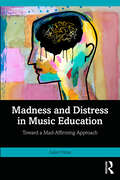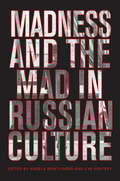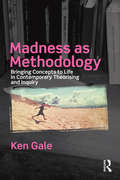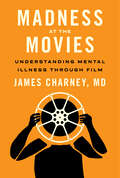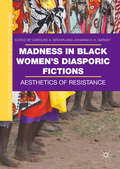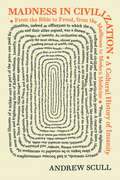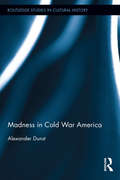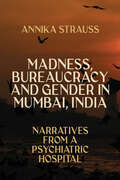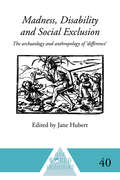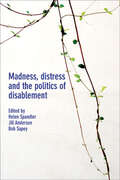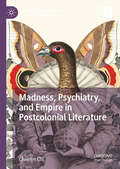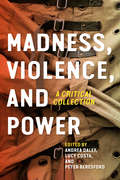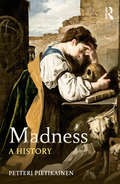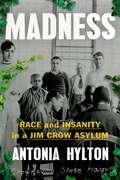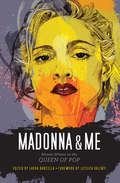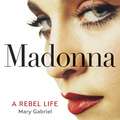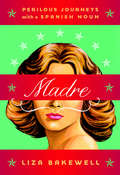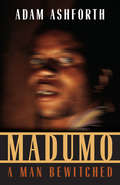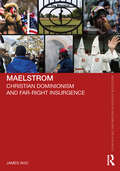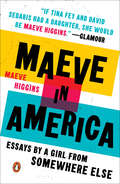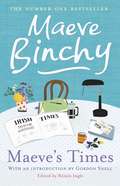- Table View
- List View
Madness and Distress in Music Education: Toward a Mad-Affirming Approach
by Juliet HessMadness and Distress in Music Education offers an in-depth exploration of mental health and emotional distress in the context of music education, offering new ways of thinking about these experiences and constructing ways to support distress through affirming pedagogy, practices, and policies in music education. Centering the lived experiences of 15 people in a range of roles across music education who self-identify an issue with their mental health, the volume addresses impacts on both students and educators. The author draws on Mad Studies and disability studies to present new paradigms for thinking about Madness and distress in the music context. An essential resource for music educators, music education researchers, and preservice students seeking to understand the complexities of mental health in the music classroom, this book considers how people conceptualize their mental health, how distress impacts participation in music education, how music education may support or exacerbate distress, and what supports for distress can be implemented in music education.
Madness and the Mad in Russian Culture
by Ilya Vinitsky Angela BrintlingerThe problem of madness has preoccupied Russian thinkers since the beginning of Russia's troubled history and has been dealt with repeatedly in literature, art, film, and opera, as well as medical, political, and philosophical essays. Madness has been treated not only as a medical or psychological matter, but also as a metaphysical one, encompassing problems of suffering, imagination, history, sex, social and world order, evil, retribution, death, and the afterlife.Madness and the Mad in Russian Culture represents a joint effort by American, British, and Russian scholars - historians, literary scholars, sociologists, cultural theorists, and philosophers - to understand the rich history of madness in the political, literary, and cultural spheres of Russia. Editors Angela Brintlinger and Ilya Vinitsky have brought together essays that cover over 250 years and address a wide variety of ideas related to madness - from the involvement of state and social structures in questions of mental health, to the attitudes of major Russian authors and cultural figures towards insanity and how those attitudes both shape and are shaped by the history, culture, and politics of Russia.
Madness as Methodology: Bringing Concepts to Life in Contemporary Theorising and Inquiry
by Ken GaleMadness as Methodology begins with the following quotation from Deleuze and Guattari, ‘Madness need not be all breakdown. It may also be breakthrough.’ This quotation firmly expresses the book’s intention to provide readers with radical and innovative approaches to methodology and research in the arts, humanities and education practices. It conceptualises madness, not as a condition of an individual or particular being, but rather as a process that does things differently in terms of creativity and world making. Through a posthuman theorising as practice, the book emphasises forms of becoming and differentiation that sees all bodies, human and nonhuman, as acting in constant, fluid, relational play. The book offers a means of breaking through and challenging the constraints and limitations of Positivist approaches to established research practice. Therefore, experimentation, concept making as event and a going off the rails are offered as necessary means of inquiry into worlds that are considered to be always not yet known. Rather than using a linear chapter structure, the book is constructed around Deleuze and Guattari’s use of an assemblage of plateaus, providing the reader with a freedom of movement via multiple entry and exit points to the text. These plateaus are processually interconnected providing a focal emphasis upon topics apposite to this madness as methodology. Therefore, as well as offering a challenge to the constraining rigours of conventional research practices, these plateaus engage with topics to do with posthuman thinking, relationality, affect theory, collaboration, subjectivity, friendship, performance and the use of writing as a method of inquiry.
Madness at the Movies: Understanding Mental Illness through Film
by James CharneyA unique exploration of how mental illness is portrayed in classic and contemporary films.The study of classic and contemporary films can provide a powerful avenue to understand the experience of mental illness. In Madness at the Movies, James Charney, MD, a practicing psychiatrist and long-time cinephile, examines films that delve deeply into characters' inner worlds, and he analyzes moments that help define their particular mental illness. Based on the highly popular course that Charney taught at Yale University and the American University of Rome, Madness at the Movies introduces readers to films that may be new to them and encourages them to view these films in an entirely new way. Through films such as Psycho, Taxi Driver, Through a Glass Darkly, Night of the Hunter, A Woman Under the Influence, Ordinary People, and As Good As It Gets, Charney covers an array of disorders, including psychosis, paranoia, psychopathy, depression, bipolar disorder, obsessive-compulsive disorder, and anxiety. He examines how these films work to convey the essence of each illness. He also looks at how each film reflects the understanding of mental illness at the time it was released as well as the culture that shaped that understanding.Charney explains how to observe the behaviors displayed by characters in the films, paying close attention to signs of mental illness. He demonstrates that learning to read a film can be as absorbing as watching one. By viewing these films through the lens of mental health, readers can hone their observational skills and learn to assess the accuracy of depictions of mental illness in popular media.
Madness in Black Women’s Diasporic Fictions
by Caroline A. Brown Johanna X. K. GarveyThis collection chronicles the strategic uses of madness in works by black women fiction writers from Africa, the Caribbean, Canada, Europe, and the United States. Moving from an over-reliance on the "madwoman" as a romanticized figure constructed in opposition to the status quo, contributors to this volume examine how black women authors use madness, trauma, mental illness, and psychopathology as a refraction of cultural contradictions, psychosocial fissures, and political tensions of the larger social systems in which their diverse literary works are set through a cultural studies approach. The volume is constructed in three sections: Revisiting the Archive, Reinscribing Its Texts: Slavery and Madness as Historical Contestation, The Contradictions of Witnessing in Conflict Zones: Trauma and Testimony, and Novel Form, Mythic Space: Syncretic Rituals as Healing Balm. The novels under review re-envision the initial trauma of slavery and imperialism, both acknowledging the impact of these events on diasporic populations and expanding the discourse beyond that framework. Through madness and healing as sites of psychic return, these novels become contemporary parables of cultural resistance.
Madness in Civilization
by Andrew ScullThe loss of reason, a sense of alienation from the commonsense world we all like to imagine we inhabit, the shattering emotional turmoil that seizes hold and won't let go--these are some of the traits we associate with madness. Today, mental disturbance is most commonly viewed through a medical lens, but societies have also sought to make sense of it through religion or the supernatural, or by constructing psychological or social explanations in an effort to tame the demons of unreason. Madness in Civilization traces the long and complex history of this affliction and our attempts to treat it.Beautifully illustrated throughout, Madness in Civilization takes readers from antiquity to today, painting a vivid and often harrowing portrait of the different ways that cultures around the world have interpreted and responded to the seemingly irrational, psychotic, and insane. From the Bible to Sigmund Freud, from exorcism to mesmerism, from Bedlam to Victorian asylums, from the theory of humors to modern pharmacology, the book explores the manifestations and meanings of madness, its challenges and consequences, and our varied responses to it. It also looks at how insanity has haunted the imaginations of artists and writers and describes the profound influence it has had on the arts, from drama, opera, and the novel to drawing, painting, and sculpture.Written by one of the world's preeminent historians of psychiatry, Madness in Civilization is a panoramic history of the human encounter with unreason.
Madness in Cold War America: Mad America (Routledge Studies in Cultural History)
by Alexander DunstThis book tells the story of how madness came to play a prominent part in America’s political and cultural debates. It argues that metaphors of madness rise to unprecedented popularity amidst the domestic struggles of the early Cold War and become a pre-eminent way of understanding the relationship between politics and culture in the United States. In linking the individual psyche to society, psychopathology contributes to issues central to post-World War II society: a dramatic extension of state power, the fate of the individual in bureaucratic society, the political function of emotions, and the limits to admissible dissent. Such vocabulary may accuse opponents of being crazy. Yet at stake is a fundamental error of judgment, for which madness provides welcome metaphors across US diplomacy and psychiatry, social movements and criticism, literature and film. In the process, major parties and whole historical eras, literary movements and social groups are declared insane. Reacting against violence at home and war abroad, countercultural authors oppose a sane madness to irrational reason—romanticizing the wisdom of the schizophrenic and paranoia’s superior insight. As the Sixties give way to a plurality of lifestyles an alternative vision arrives: of a madness now become so widespread and ordinary that it may, finally, escape pathology.
Madness, Bureaucracy and Gender in Mumbai, India: Narratives from a Psychiatric Hospital
by Annika StraussRegional mental hospitals in India are perceived as colonial artefacts in need of reformation. In the last two decades, there has been discussion around the maltreatment of patients, corruption and poor quality of mental health treatment in these institutions. This ethnography scrutinizes the management of madness in one of these asylum-like institutions in the context of national change and the global mental health movement. The author explores the assembling and impact of psychiatric, bureaucratic, gendered and queer narratives in and around the hospital. Finally, the author attempts to reconcile social anthropology and psychiatry by scrutinising their divergent approaches towards ‘mad narratives’.
Madness, Disability and Social Exclusion: The Archaeology and Anthropology of 'Difference' (One World Archaeology #Vol. 40)
by Jane HubertA unique work that brings together a number of specialist disciplines, such as archaeology, anthropology, disability studies and psychiatry to create a new perspective on social and physical exclusion from society. A range of evidence throws light on such things as the causes and consequences of social exclusion stigma, marginality and dangerousness.It is an important text that breaks down traditional academic disciplinary boundaries and brings a much needed comparative approach to the subject.
Madness, Distress and the Politics of Disablement
by Helen Spandler, Jill Anderson and Bob SapeyThis book explores the challenges of applying disability theory and policy, including the social model of disability, to madness and distress. It brings together leading scholars and activists from Europe, North America, Australia and India, to explore the relationship between madness, distress and disability. Whether mental health problems should be viewed as disabilities is a pressing concern, especially since the inclusion of psychosocial disability in the UN Convention on the Rights of Persons with Disabilities. This book will appeal to policy makers, practitioners, activists and academics.
Madness, Psychiatry, and Empire in Postcolonial Literature (Palgrave Studies in Literature, Science and Medicine)
by Chienyn ChiMadness, Psychiatry, and Empire in Postcolonial Literature provides a comparatist interrogation of empire through archives of history, science, and literature. The book analyzes Aimé Césaire’s Discourse on Colonialism to shed light on Césaire’s critique of psychological and medical discourses of the colonized’s mind. The book argues that the discourse of psychiatry, psychology, and psychoanalysis has erased the context of power in global histories of empire. Through the book’s chapters, Chi analyzes Lu Xun’s “A Madman’s Diary,” Virginia Woolf’s Mrs. Dalloway, and Tsitsi Dangarembga’s Nervous Conditions to assert that the misapprehension of madness should not automatically be accepted as the history of an isolated Western culture but rather that of the history of imperialism—a globalizing process that silences alternative cultural conceptions of the mind, of madness, and of behavior, as well as different interpretations of madness.
Madness, Violence, and Power: A Critical Collection
by Peter Beresford Andrea Daley Lucy CostaMadness, Violence, and Power: A Critical Collection disengages from the common forms of discussion about violence related to mental health service users and survivors which position those users or survivors as more likely to enact violence or become victims of violence. Instead, this book seeks to broaden understandings of violence manifest in the lives of mental health service users/survivors, ‘push’ current considerations to explore the impacts of systems and institutions that manage ‘abnormality’, and to create and foster space to explore the role of our own communities in justice and accountability dialogues. This critical collection constitutes an integral contribution to critical scholarship on violence and mental illness by addressing a gap in the existing literature by broadening the “violence lens,” and inviting an interdisciplinary conversation that is not narrowly biomedical and neuro-scientific.
Madness: A History
by Petteri PietikäinenMadness: A History is a thorough and accessible account of madness from antiquity to modern times, offering a large-scale yet nuanced picture of mental illness and its varieties in western civilization. The book opens by considering perceptions and experiences of madness starting in Biblical times, Ancient history and Hippocratic medicine to the Age of Enlightenment, before moving on to developments from the late 18th century to the late 20th century and the Cold War era. Petteri Pietikäinen looks at issues such as 18th century asylums, the rise of psychiatry, the history of diagnoses, the experiences of mental health patients, the emergence of neuroses, the impact of eugenics, the development of different treatments, and the late 20th century emergence of anti-psychiatry and the modern malaise of the worried well. The book examines the history of madness at the different levels of micro-, meso- and macro: the social and cultural forces shaping the medical and lay perspectives on madness, the invention and development of diagnoses as well as the theories and treatment methods by physicians, and the patient experiences inside and outside of the mental institution. Drawing extensively from primary records written by psychiatrists and accounts by mental health patients themselves, it also gives readers a thorough grounding in the secondary literature addressing the history of madness. An essential read for all students of the history of mental illness, medicine and society more broadly.
Madness: Race and Insanity in a Jim Crow Asylum
by Antonia HyltonIn the tradition of The Immortal Life of Henrietta Lacks, this New York Times bestseller is a page-turning account of one of the nation&’s last segregated asylums..."a book that left me breathless" (Clint Smith). For centuries, Black patients have been absent from our history books. Madness transports readers through the ninety-three-year history of Crownsville Hospital, one of the last segregated asylums with surviving records and a campus that still stands to this day in Anne Arundel County, Maryland. Antonia Hylton blends the intimate tales of patients and employees whose lives were shaped by Crownsville with a decade-worth of investigative research and archival documents. Madness chronicles the stories of Black families whose mental health suffered as they tried, and sometimes failed, to find safety and dignity. Hylton also grapples with her own family&’s experiences with mental illness, and the secrecy and shame that it reproduced for generations. As Crownsville Hospital grew from an antebellum-style work camp to a tiny city sitting on 1,500 acres, the institution became a microcosm of America&’s evolving battles over slavery, racial integration, and civil rights. Hylton traces the legacy of slavery to the treatment of Black people&’s bodies and minds in our current mental healthcare system. It is a captivating and heartbreaking meditation on how America decides who is sick or criminal, and who is worthy of our care or irredeemable.
Madonna and Me: Women Writers on the Queen of Pop
by Jessica Valenti Laura BarcellaFor nearly 30 years, Madonna has been at the center of the media spotlight. She has sold more than 200 million records worldwide, launched her own record label, headlined an Oscar-award-winning film, authored bestselling books for both adults and children, inspired global street-fashion trends, and instigated international debates over a range of feminist issues from sexual fetish to adoption ethics. Masterfully harnessing her talent and power to navigate her ascent to stardom, she has become the very definition of iconic.She has also been a constant companion. In Madonna and Me, more than forty women write about Madonna's influence on their lives. No subject goes unexplored-from sex and money to fashion and identity, the stories are just as brazen, bold, and balls-to-the-wall as Madonna. They explore the evolution of her chameleonlike personas-material girl and "boy-toy" tartlet, kooky Kabbalist and savvy businesswoman, siren and mother-and her impact on culture as a groundbreaking feminist.Of course, not all women worship at her altar, and likewise the essays in Madonna and Me are brutally honest, funny, engaging, and real. They delve into the hearts, souls, memories, and moments of contemporary women, celebrating the ways in which Madonna has inspired us and challenged us, pushing us to be bolder, edgier, braver versions of ourselves.
Madonna: A Rebel Life - The Biography
by Mary GabrielIn this exceptional biography, Pulitzer Prize finalist Mary Gabriel chronicles the meteoric rise and enduring influence of the greatest female pop icon of the modern era: Madonna.'Daring to write a biography of a woman with whom the entire world is on a first-name basis, Mary Gabriel has created (astonishingly) a book neither gossip-driven nor highly snarky... she reveals instead a Madonna both more true and more unbelievably believable; a rock-and-roll suffragette... Norman Mailer once said to Madonna, 'I've come to the conclusion that you are a great artist.' Exquisitely detailed in her storytelling, Gabriel is clearly in that camp, convincing us that we all still vogue in the House of Madonna.'Brad Gooch, author of City Poet With her arrival on the music scene in the early 1980s, Madonna generated nothing short of an explosion - as great as that of Elvis or the Beatles - taking the nation by storm with her liberated politics and breathtaking talent. But Madonna was more than just a pop star. Everywhere, fans gravitated to her as an emblem of a new age, one in which feminism could shed the buttoned-down demeanour of the 1970s and feel relevant to a new generation. Amid the scourge of AIDS, she brought queer identities into the mainstream, fiercely defending a person's right to love whomever - and be whoever - they wanted. Despite fierce criticism, she never separated her music from her political activism. And as an artist, she never stopped experimenting. Madonna existed to push past boundaries by creating provocative, visionary music, videos, films and live performances that changed culture globally. Deftly tracing Madonna's story from her Michigan roots to her rise to super-stardom, master biographer Mary Gabriel captures the dramatic life and achievements of one of the greatest artists of our time.
Madonna: A Rebel Life - The Biography
by Mary Gabriel'A whopping biography of the pop phenomenon and queen of reinvention. Life is a mystery - hers oughtn't to be after reading this.' THE TIMES, ' biggest books for autumn''A fascinating take on one of music's greatest icons' BELFAST TELEGRAPHIn this exceptional biography, Pulitzer Prize finalist Mary Gabriel chronicles the meteoric rise and enduring influence of the greatest female pop icon of the modern era: Madonna.'Daring to write a biography of a woman with whom the entire world is on a first-name basis, Mary Gabriel has created (astonishingly) a book neither gossip-driven nor highly snarky... she reveals instead a Madonna both more true and more unbelievably believable; a rock-and-roll suffragette... Norman Mailer once said to Madonna, 'I've come to the conclusion that you are a great artist.' Exquisitely detailed in her storytelling, Gabriel is clearly in that camp, convincing us that we all still vogue in the House of Madonna.'Brad Gooch, author of City Poet With her arrival on the music scene in the early 1980s, Madonna generated nothing short of an explosion - as great as that of Elvis or the Beatles - taking the nation by storm with her liberated politics and breathtaking talent. But Madonna was more than just a pop star. Everywhere, fans gravitated to her as an emblem of a new age, one in which feminism could shed the buttoned-down demeanour of the 1970s and feel relevant to a new generation. Amid the scourge of AIDS, she brought queer identities into the mainstream, fiercely defending a person's right to love whomever - and be whoever - they wanted. Despite fierce criticism, she never separated her music from her political activism. And as an artist, she never stopped experimenting. Madonna existed to push past boundaries by creating provocative, visionary music, videos, films and live performances that changed culture globally. Deftly tracing Madonna's story from her Michigan roots to her rise to super-stardom, master biographer Mary Gabriel captures the dramatic life and achievements of one of the greatest artists of our time.
Madrasas in South Asia: Teaching Terror? (Routledge Contemporary South Asia Series)
by Jamal MalikAfter 9/11, madrasas have been linked to international terrorism. They are suspected to foster anti-western, traditionalist or even fundamentalist views and to train al-Qaeda fighters. This has led to misconceptions on madrasa-education in general and its role in South Asia in particular. Government policies to modernize and ‘pacify’ madrasas have been precipitous and mostly inadequate. This book discusses the educational system of madrasas in South Asia. It gives a contextual account of different facets of madrasa education from historical, anthropological, theological, political and religious studies perspectives. Some contributions offer recommendations on possible – and necessary – reforms of religious educational institutions. It also explores the roots of militancy and sectarianism in Pakistan, as well as its global context. Overall, the book tries to correct misperceptions on the role of madrasas, by providing a more balanced discussion, which denies neither the shortcomings of religious educational institutions in South Asia nor their important contributions to mass education.
Madre and I: A Memoir of Our Immigrant Lives
by Guillermo A. ReyesIn this moving and funny memoir, award-winning playwright Guillermo Reyes untangles his life as the secretly illegitimate son of a Chilean immigrant to the United States and as a young man struggling with sexual repression, body image, and gay identity. But this is a double-decker memoir that also tells the poignant, bittersweet, and adventurous story of Guillermo's mother, Maria, who supports herself and her son cleaning houses and then working as a nanny in Washington, D. C. and eventually in Hollywood. In one memorable scene, after realizing that her friend Carmen is cleaning the house of one of the producers of Annie Hall, Maria recruits her to take her picture as she poses dramatically with Mr. Joffe's Oscar in hand. It is Maria's defiant yet determined attitude amidst her sacrifices that allows for Guillermo's spirited coming of age and coming out. Their common ground is the drama of their encounters with discovery, heartbreak, and passion--the explosive emotions that light up the stage of their two-actor theater. Honorable Mention, Best Auto/Biography in English, International Latino Book Awards
Madre: Perilous Journeys with a Spanish Noun
by Liza BakewellWhy is the word madre, "mother," so complicated in Spanish--especially in Mexico? Leaping off the page with energy, insight, and attitude, Liza Bakewell's exploration of language is anything but "just semantics." Why does me vale madre mean worthless, while !qué padre! means fabulous, she asks? And why do one hundred madres disappear when one padre enters the room, converting the group from madres to padres? Thus begins a journey through Mexican culture in all its color: weddings, dinner parties, an artist's studio, heart-stopping taxi rides, angry journalists, corrupt politicians, Blessed Virgins, and mothers both sacred and profane. Along the way, a reader discovers not only an invaluable lexicon of Mexican slang (to be used with caution or not at all) but also thought-provoking reflections on the evolution of language; its winding path through culture, religion, and politics; and, not least, what it means--and what it threatens--to be a creative female, a madre.
Madumo: A Man Bewitched
by Adam AshforthThe author tells a story about his friend, a young man named Madumo, struggling to free himself from the curse of witchcraft in Soweto, South Africa. It is based upon shared experiences and taped conversations, interviews and discussions with others, journals, and letters.
Maelstrom: Christian Dominionism and Far-Right Insurgence (Routledge Studies in Fascism and the Far Right)
by James AhoMaelstrom: Christian Dominionism and Far-Right Insurgence illuminates the latest outbreak of right-wing extremism in America. This book reviews the cyclical nature of right-wing resurgences in American history, dismisses the appropriateness of the word “fascism” to explain them, and then describes in depth the goal of “reconstructing” American institutions on the basis of biblical principles. It critiques the popular view that far-right politics is carried by stupid, socially isolated, nuts. To this end, it discusses the logicality of the “big lie” and examines in detail how people are recruited into the far-right, by entertaining the theories of authoritarianism and resource mobilization. Finally, it characterizes how the ends-oriented rationality of far-right activists differs from the mini-max criterion of rationality utilized by the ordinary person. This can motivate them to be violent and can frustrate efforts by the government to control them.
Maeve in America: Essays by a Girl from Somewhere Else
by Maeve Higgins“If Tina Fey and David Sedaris had a daughter, she would be Maeve Higgins.” —Glamour“Maeve Higgins is hilarious, poignant, conversational, and my favorite Irish import since U2. You’re in for a treat.” —Phoebe RobinsonA timely essay collection about life, love, and becoming an American from breakout comedy star and podcaster Maeve Higgins Maeve Higgins was a bestselling memoirist and comedian in her native Ireland when, at the grand old age of thirty-one, she left the only home she’d ever known in search of something more. Like many women in their early thirties, she both was and was not the adult she wanted to be. At once smart, curious, and humane, Maeve in America is the story of how Maeve found herself, literally and figuratively, in New York City. Here are stories of not being able to afford a dress for the ball, of learning to live with yourself while you’re still figuring out how to love yourself, of the true significance of realizing what sort of shelter dog you would be. Self-aware and laugh-out-loud funny, this collection is also a fearless exploration of the awkward questions in life, such as: Is clapping too loudly at a gig a good enough reason to break up with somebody? Is it ever really possible to leave home? Together, the essays in Maeve in America create a startlingly funny and revealing portrait of a woman who aims for the stars but hits the ceiling, and the inimitable city that has helped shape who she is, even as she finds the words to make sense of it all.
Maeve's Times
by Maeve Binchy'Maeve's Times is funny and clever and kind, which are excellent qualities in both books and people' Irish Times'As someone who fell off a chair not long ago trying to hear what they were saying at the next table in a restaurant, I suppose I am obsessively interested in what some might consider the trivia of other people's lives.'Maeve Binchy is well known for her bestselling novels, but for many years Maeve was a journalist. From 'The Student Train' to 'Plane Bores' and 'Bathroom Joggers' to 'When Beckett met Binchy', these articles have all the warmth, wit and humanity of her fiction. Arranged in decades, from the 1960s to the 2000s, and including Maeve's first and last ever piece of writing for the Irish Times, the columns also give a fascinating insight into the author herself.With an introduction written by her husband, the writer Gordon Snell, this collection of timeless writing reminds us of why the leading Irish writer was so universally loved.
Maeve's Times
by Maeve Binchy'Maeve's Times is funny and clever and kind, which are excellent qualities in both books and people' Irish Times'As someone who fell off a chair not long ago trying to hear what they were saying at the next table in a restaurant, I suppose I am obsessively interested in what some might consider the trivia of other people's lives.'Maeve Binchy is well known for her bestselling novels, but for many years Maeve was a journalist. From 'The Student Train' to 'Plane Bores' and 'Bathroom Joggers' to 'When Beckett met Binchy', these articles have all the warmth, wit and humanity of her fiction. Arranged in decades, from the 1960s to the 2000s, and including Maeve's first and last ever piece of writing for the Irish Times, the columns also give a fascinating insight into the author herself.With an introduction written by her husband, the writer Gordon Snell, this collection of timeless writing reminds us of why the leading Irish writer was so universally loved.
